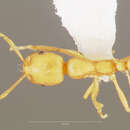The Pharoah ant, or sugar ant, (
Monomorium pharaonis) is sometimes incorrectly referred to as Pharoah’s ant on the web and publications. Thought to have originated in Africa or perhaps Malaysia, this small (2 mm) yellow ant is now common and widespread around the globe as a difficult to control household ant. It infests buildings of all sorts, in all climates (it will only nest outdoors in tropical or temperate areas), from houses to bakeries to hospitals, getting into any possible food source, including toothpaste and shoe polish. Colonies can be found nesting in a tremendous diversity of places (e.g. light fixtures, between sheets, inside insulation, in baseboards). Pharoah ants can transmit multiple pathogenic bacteria, such as
Salmonella and
Streptococcus making them a dangerous pest in hospitals, as they routinely make trails between unhygienic areas and medical equipment, sterile dressings, patients with wounds, etc. Non-repellant bait traps using chemicals such as boric acid and insect growth regulator are the most effective and simple methods of control. Repellants may cause a colony to bud off into multiple new colonies. (
Morris 2000;
Nickerson and Harris 2007;
Wikipedia 2011)

